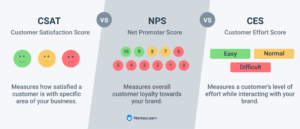- Keeping a keen eye on the metrics to stay the course
Peter Drucker the management guru (of blessed memory) is known for his seminal contributions to the field of business and management. Among the (plethora of) contributions attributed to this great man include the following quote “You can’t improve what you don’t measure.” As much as measurements must not be seen as an end in and of themselves, we must get the balance right to ensure that we avoid consigning them to irrelevance. Therefore, we measure to complement our efforts to keep us aligned with our customers’ needs.
His assertion is further emphasized by a British physicist and mathematician, William Thomson Kelvin, who left us with the following phrase: “What is not defined cannot be measured. What is not measured, cannot be improved. What is not improved, is always degraded.” By defining measurable goals to establish the desired outcome, we position ourselves to improve upon whatever it is we have set our minds to.
For example, to lose weight we must at some point step on a scale to measure our results. If we fail to do this we will have no idea if we are succeeding in our weight loss programme or not. A major requirement in any CX programme is the ability to know your customer. As a business, this will mean having a common understanding of the customer across the business. This is referred to as the Voice of the Customer (VOC) programme. It helps us to understand our customers dynamically and consistently.
The business strategy lays out the markets, methods, objectives, and metrics of organizational success while the brand strategy sets expectations with customers. A CX programme helps us understand how our customers respond to the delivery of our business and brand strategies. How we gather the feedback and harness it for the business good is a key part of the VoC effort. Listening to our customers’ feedback continuously will help us know exactly when, where, and what to act on.
A few tips on intelligence gathering offered by experts and researchers include (and are not limited to) the following: facilitating a VoC programme, gathering data, and, choosing metrics.
VoC Programme
A major part of implementing a CX programme is listening to the Voice of the customer (VoC). This is the process of gathering and analyzing customer data about a brand or its products and services to improve the company’s processes, products and services, and overall customer satisfaction. Note that when gathering VoC data it is important to also consider negative customer feedback as it is equally helpful feedback.
This is because it can bring to light certain customer pain points that, once fixed, can greatly improve the customer experience (CX), and product experience (PX), and inform product development. There is a plethora of sources to draw from in your VoC study. A few examples include customer surveys, Interviews, focus groups, website behaviour, email, live chat and customer support, a customer success team, social media, and, online reviews.

Source: monkeylearn.com
The following surveys used frequently provide key listening capabilities. The Customer Satisfaction Score (CSAT) is a questionnaire that businesses use to collect feedback from customers. Its purpose is to measure how satisfied customers are with your brand, products, or services, and the level of customer service. The Net promoter score (NPS), is a customer experience management (CXM) metric designed to gauge customer loyalty by asking customers how likely they are to recommend a company on a scale of 0-10.
“On a scale from 0-10, how likely are you to recommend this company to a friend or colleague?” Your scores, once gathered, are then divided into three groups: Promoters, Passives, and Detractors. Detractors (scores 0 – 6), are unsatisfied customers that could potentially share negative feedback about your business. They are also more likely to churn. Passives (scores 7 – 8) are indifferent to your company.
But you will need to keep an eye on these customers because they are at risk of becoming Detractors, which might lead to increased customer churn. On the upside, you might be able to turn them into Promoters. Promoters (scores 9 – 10) are loyal customers that are very likely to promote your company through word of mouth. They are your company advocates, so you want to keep these loyal customers happy. The customer effort score (CES) is a customer satisfaction metric that shows a customer’s level of effort while interacting with your company.
It is a quick pulse check on how easy it is for customers to resolve their issues or use your products and services. It is also a good indicator of future loyalty. One industry that has seen significant and rapid change and disruption in recent decades is banking and personal finance. If we could do such pulse checks for our market women, retail outlets, local stores, and (my favourite) “waakye” sellers that will potentially add value when they become aware and align with the customer experience for their service.
Consider this use case. A Johannesburg bank wanted to perform a comprehensive sentiment analysis on customer feedback, across both official channels and social media platforms. Their efforts included a hashtag-based campaign to ask customers what they loved and hated about their bank, which generated over two million pieces of text. Working methodically through volumes of data, they collaborated with the clients to create several custom categories into which to sort comments.
Categories were created for fees, branch banking, and mobile banking comments among others. They then broke comments up into constituent parts and allocated a sentiment score (for positive, negative, or neutral emotional responses). This allowed them to identify clear themes within the data as well as provide a statistical breakdown of which areas needed the closest attention and focus.
Gathering intelligence
As highlighted data gathered from various sources present you opportunities to assess the sentiments of your customers objectively. Customer Relationship Management Systems help develop a mass of data with the capability to make sense of customer feedback from the information generated with the toolkit. The algorithms behind these tools enhance your information management capabilities in more ways than one.
For example, using machine learning tools enables you to analyze both quantitative and qualitative data, so you can get the stats and percentages and the opinions and feelings of your customers. You also have further capabilities to integrate your analysis tools with customer support systems such as Zendesk (just for example purposes) an intuitive customer support system that empowers sales teams to engage interactively with its integration functionalities. The goal is to use tools that enable you to keep all your customer data in one place.
Data from these sources become more meaningful if senior managers and CX leaders complement it with several other approaches offered by the use of what Jeff Sheehan, CX Consultant, refers to as “free listening posts.” These include first, senior executives and the CX leader can live the life of an agent for a day by taking calls, and sitting in agent training sessions observing how their work is done. Additionally, product managers can sit with call centre agents to learn what causes customer complaints and how they might address them in their design process.
Second, one can use mystery shopping, Executives and CX leaders interact with all channels for first-hand experience of what you put your customers through. Score these experiences using your internal QA process. Third, use interactive research by spending time with agents and managers on what they are experiencing and ideas for improvements (part of the employee experience). Fourth, develop an executive playlist of customer calls, make CX peogramme valuable by influencing senior managers with real customer voices, and, fifth, publishing CX good news, the status of projects, highlight top formers, and share real customer stories to keep the CX programme “top-of-mind and inclusive.”
Choosing metrics
Your goal is to align CX metrics with the business strategy, brand promises, and CX strategy of your company. The way forward to achieving the alignment you seek is to develop a framework encompassing layers of CX metrics and constantly challenging every metric used with a “why” to hone it to the essentials vital for your organization and your customer. First, you develop metrics to assess the business impact of your CX programme. How does it align with your revenue, cost, and, brand reputation?
Generally, your business outcomes come down to a few basic things: Whether your prospects are finding your brand when they have a need (awareness), or believing your company can provide that need (findability and reputation). Are they buying what you are selling (conversion)? Are they happy to be your customer Not just after the first sale, but in an ongoing relationship (repeat buying)?? Are they telling others about your brand? Are they doing so positively or negatively (advocacy)?
Customer relationship metrics measure the aggregate of what customers do as a consequence of their experience with and perceptions of the organization from their interactions. Your journey map will help you assess whether customers are finding the experience worthwhile and are willing to come back. what pain points you have to address as a result of the findings will keep you alive to the needs of your customer. Their perceptions ate your journey touchpoints offer you an opportunity to have them define the metrics that is important to them.
Use similar tactics laid out above to understand your employees’ opinions: surveys, focus groups, etc, and put their feedback to use on internal issues and customer-facing processes.
Customer Experience Professionals Ghana Presents the Annual Customer Experience Professionals Ghana Conference, a cross-industry meeting place bringing together over 300 global thought leaders, professionals, and innovative solution providers in Ghana.
The theme for this year’s conference is “Accelerating Growth Through Customer Experience: The Case of Organizations and Industries.” Date: Thursday, 6th October 2022 Time: 09:00 a.m. Venue: Labadi Beach Hotel, Accra, Ghana. Contact 0552 760 129, email: [email protected], online: www.cxpghana.com.
The Writer is a Management Consultant (Change and Customer Experience). He can be reached on 059 175 7205, [email protected], https://www.linkedin.com/in/km-13b85717/










